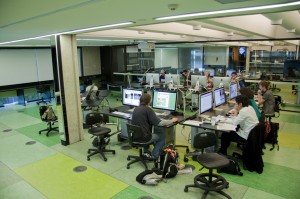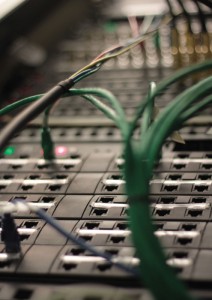In our current financial climate, being a successful artist also means being a successful micro business offering something unique.
Advancements in technology present new tools to all businesses who care to take advantage of them – whether their product is paintings or paperclips.
In February 2010, a new centre for digital culture, The Edge, opened its doors. Located in Brisbane, it was created by the Queensland Government as a vehicle for young and emerging creative professionals and is designed as a stepping-stone, delivery platform and test space for new ideas.
The centre is dedicated to creativity, defined in the broadest possible terms to include skill areas beyond those traditionally thought of as the creative fields. So far, this includes software coders, environmental scientists, robotics engineers, urban informatics researchers and entrepreneurs in creative businesses. Also present are musicians, visualists, kinetic sculptors, illustrators, filmmakers, writers and journalists.
Its focus is on providing free tools to encourage greater experimentation—software, hardware, space, mentors, residency programs and support in the hope that having access to The Edge will encourage people to take risks that wouldn’t be feasible otherwise.
With brand new facilities and equipment, users are actively engaging with the space to make it what they want it to be. Since opening, The Edge has presented over 60 programs and averaged around 1200 visitors to the building and 20,000 visitors to the online space per month. The Edge is taking a deliberate, giant step into the unknown and uncertain, and comes with high expectations from the Government and creative industries about how it can, and does, work.
While a niche concept, The Edge is hardly alone in the world. It is one of a suite of technology-focused centres that are popping up all over Australia including Melbourne’s Signal, ICE in Sydney, Broken Hill’s media lab and the world including Canada’s Banff Centre, New York’s Eyebeam, Kenya’s iHub. We expect to see an increase in nodes appearing that support this kind of activity.
The open source culture of the global web technology community encourages creators to share ideas, collaborate and co create. This openness and willingness to connect means that new technological tools and applications are being generated quicker than ever, leading to the massive growth in their accessibility for all users.

Facilities at the Edge_Lab1
Working with technology is now an essential part of all creative practice, even if that means simply maintaining an email account. For many creative professionals, however, leveraging technology means so much more.
The numerous tools mean more avenues for finding collaborators, clients and commissioners, and even just likeminded people whose work you appreciate and vice versa. With all of these avenues available, any creative practitioner who doesn’t use them is at a disadvantage.
As one participant in The Edge’s Resident program (an in-house tenure for creative practitioners), digital poet and net artist Jason Nelson comments, “It’s vital to apply the same level of creativity to distribution and promotion of your work as you do in the creation of it.”
We hope that by supplying tools for creation, opportunities for connection and collaboration, and resources for entrepreneurialism, The Edge will support the further growth of a sustainable creative community in Brisbane and beyond. This development sees us edging towards the ubiquitous computing promised by science fiction for eons.
Sarah Jansen
Sarah Jansen is Communications Coordinator at The Edge, taking care of copy writing, social media, collateral distribution and media relations. Over the last 10 years, she has divided her time fairly evenly between marketing for the independent arts sector (Vibewire, This Is Not Art, Straight Out Of Brisbane) and corporate communications for the private infrastructure sector (Communikate, Parsons Brinckerhoff, Hyder Consulting).
 This work is licensed under a Creative Commons Attribution-NonCommercial-ShareAlike 3.0 Australia.
This work is licensed under a Creative Commons Attribution-NonCommercial-ShareAlike 3.0 Australia.







